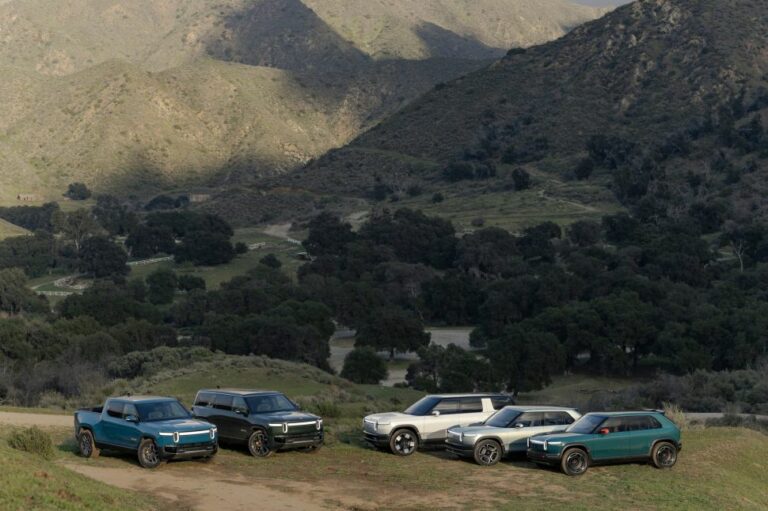Rivian’s Design Philosophy: Blending Adventure, Innovation, and Playfulness
Rivian, the electric vehicle maker that has captured attention with its focus on adventure and sustainability, is expanding its lineup beyond the established R1T pickup and R1S SUV. The company’s design philosophy, however, is as unique as its vehicles. From unexpected sources of inspiration to a user interface that embraces playful elements, Rivian is striving to create a distinctive brand identity.

As Jeff Hammoud, Rivian’s chief design officer, explained, “Good design, especially in automotive, is: Can you close your eyes and still remember it?” He further noted, “That’s what I think we did a good job of being able to achieve here.” The company’s focus on adventure is evident in the design of its vehicles. The carabiner – a metallic hook favored by rock climbers – serves as a surprisingly rich source of inspiration. The distinct oval headlights, for example, subtly echo the shape of a climbing clip. The design team drew inspiration from gear like backpacks and hiking shoes for material and color ideas.
Hammoud, who joined Rivian in 2017 after a career at Jeep, became set on automotive design at the age of six after flipping through car books his father received from Mercedes Benz. In the years since, he’s managed to carve out a unique design identity for Rivian. Color plays a key role, with Rivian’s subtle earth tones setting it apart from competitors. While the standard whites, blacks, and grays are available, Rivian offers distinctive options such as the limited California Dune Edition, a versatile pale goldish sand color. These options are also designed with practicality in mind.
“The take rate on them—and this is for any automotive brand—is relatively low, but the people who get them absolutely love them,” said Hammoud. The beige-colored California Dune R1, for example, was specifically chosen to conceal dust from sandy terrains like California’s Joshua Tree. This means Rivian’s EVs aren’t “just easy to clean, but stay looking clean longer,” said Hammoud.
Rivian’s commitment to enabling adventures extends to interior features. The woven floor mats, for instance, come in neutral tones to disguise dirt, and a discreet cargo tunnel is designed to stow gear. At prices starting around $70,000, the R1T and R1S represent premium offerings. The company is simultaneously pushing towards wider EV adoption with more affordable models.
Addressing a crowd at SXSW, RJ Scaringe, Rivian’s CEO, noted that in order to enable widespread EV adoption, “we need choice.” This is the impetus behind the upcoming R2, which will debut next year with a $45,000 starting price. “I often say the R2 will be the best thing we’ve ever developed,” Scaringe stated. He added that the R2 combines the R1’s “magic” with “tons of innovation around cost and manufacturing efficiency.” The R3 and sportier R3X models will follow.
Designing the R2, which effectively compresses the R1S into a mid-sized SUV with a more athletic feel was not an easy task. “With R1S and R1T, it was more around design through addition. We got to throw the kitchen sink at those vehicles,” Hammoud explained. “With R2, it’s design through subtraction—really trying to figure out: what are the key elements that we want to keep?” The R3 and R3X models, inspired by 1980s Group B rally cars, are Rivian’s smallest vehicles yet and are designed to be the most affordable as well.
Innovation within a familiar brand is a balancing act. “If you throw everything away and start over, then it’s hard to really establish identity,” Hammoud noted. Rivian appears to be seeking a middle ground, avoiding the complete vehicle overhauls or negligible changes seen by other auto brands. This approach extends to the user interface. Instead of the hyper-realistic renderings common in other EVs, Rivian’s touchscreen employs cartoon-style cell shading.
The inspiration for the unique visuals comes from Japanese manga and Studio Ghibli animation. The user interface incorporates 3D objects such as spinning windmills and waving blades of glass, with the scenes changing per the drive mode. The car depicted on-screen is rendered with accuracy, down to the color of the wheels. The company’s playful approach continues through details like Gear Guard Gary, a cartoon Yeti that acts as the company’s mascot and signals that Rivian’s security system is in use.
“It’s just one of those things that’s kind of special,” concluded Hammoud. “We like to have those little moments of joy.”



